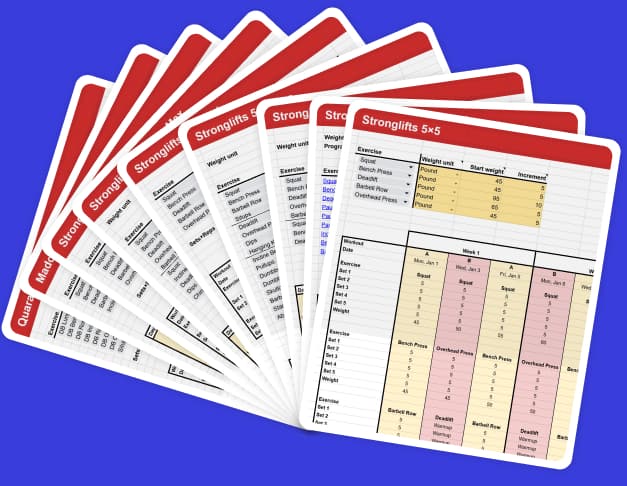Quarantine is a dumbbell hotel gym workout to build strength and muscle. It’s handy for Stronglifters stuck in a hotel gym while traveling. Beginners can also do this program if they don’t have access to barbells to do Stronglifts 5×5.
The Quarantine program is based on dumbbell workouts that I did in a hotel gym during a 14 day quarantine during the 2020 Covid-19 lockdowns. This experience inspired me to create what many Stronglifters had been asking for a while: a dumbbell-only workout that can be done in a hotel gym.
Let me show you how the Quarantine program works.
Contents
- What is the Quarantine Dumbbell Hotel Gym Workout?
- Muscles worked with the Quarantine Workout
- Workout Schedule of Quarantine
- Sets & Reps of Quarantine
- Weekly Training Volume of Quarantine
- How The Quarantine Program Came to Be
- Quarantine FAQs
- What if I don’t have a bench?
- What if I don’t have an incline bench?
- How inclined should the bench be?
- Why not do 5×5?
- Why not call this Stronglifts 5×5 Dumbbells?
- How to progress?
- Why do different templates have different reps?
- What if I fail reps?
- How to switch back to Stronglifts 5×5?
- Should you deload when resuming Stronglifts 5×5?
- 5×12 means 6 or 12 reps per leg?
- Should you rest before doing the other side?
- 5×12 50lb means 25 or 50lb per side?
- References
Join the Stronglifts community to get free access to all the spreadsheets for every Stronglifts program. You’ll also get daily email tips to stay motivated. Enter your email below to sign up today for free.
What is the Quarantine Dumbbell Hotel Gym Workout?
Quarantine is a strength and muscle building program that you can do using only a pair of dumbbells and a bench. You can use this program as a backup if you’re stuck in a hotel gym while traveling and can’t do Stronglifts 5×5. You can also do this program at home if you only have dumbbells.
The Quarantine program consists of two workouts A and B. You do three workouts per week as I’ll explain below.
| Quarantine Dumbbell-only Program | |
|---|---|
| Workout A | Workout B |
| DB Lunges 5×12 | DB Romanian Deadlift 5×12 |
| DB Bench Press 5×12 | DB Incline Bench Press 5×12 |
| DB Row 5×12 | DB Overhead Press 5×12 |
| DB Curl 3×12 | Situps 3×12 |
5×12 is five sets of twelve reps. On unilateral exercises like DB Lunges, this means twelve reps per leg (24 total). 3×12 is three sets of twelve reps. There is no 5×5 on this program. I’ll explain why in the FAQs below.
You can log the Quarantine program using the Stronglifts app. Just tap the program tab at the bottom and then select Quarantine from the list. You’ll find videos and instructions for every exercise.
Muscles worked with the Quarantine Workout
Quarantine is a full body strength and muscle building program. Each workout you do exercises for your upper and lower body. Here’s an overview…
| Quarantine Muscles Worked | |
|---|---|
| Workout A | Workout B |
| Quads/Glutes Lunges | Hams/Glutes RDL |
| Chest/Shoulders/Triceps Bench | Chest/Shoulders/Triceps Bench |
| Back/Biceps Row | Shoulders/Triceps OHP |
| Biceps Curl | Abs Situp |
Both workouts start with an exercise that works your legs. Next you do two exercises for your upper body. You finish with isolation for your biceps or abs. These two simple workouts work all your major muscle groups.
If you can’t or don’t want to do some of these exercises, check the program variations in the Stronglifts app. Tap program, select Quarantine, then swipe left/right to view alternative templates. You can also tap “replace exercises” to get a list of substitute exercises to choose from, or create your own.
Workout Schedule of Quarantine
Quarantine is a 3x/week dumbbell program.
Do three workouts a week. Alternate workouts A and B each time you train. The most common schedule is Monday, Wednesday, and Friday.
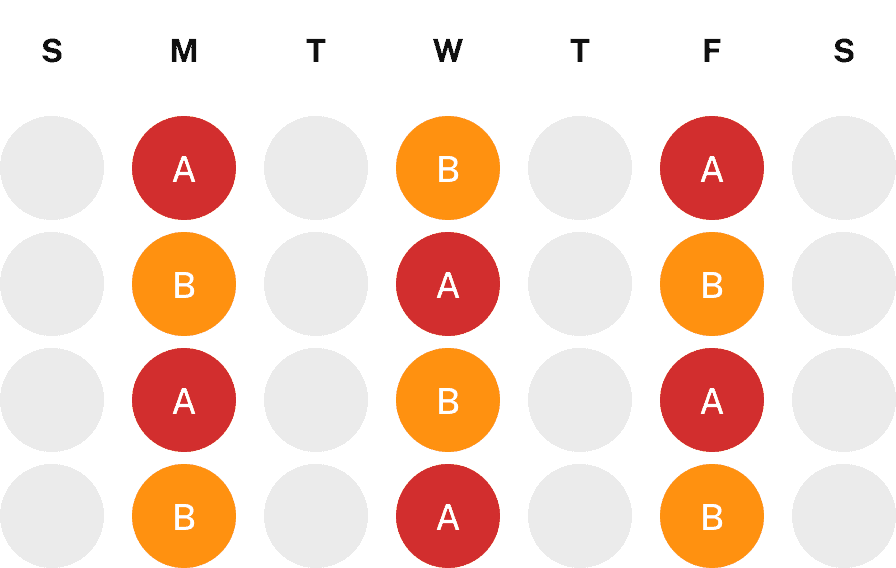
Many other workout schedules can work. For example: Tuesday, Thursday, and Saturday, or Sunday, Wednesday, and Friday.
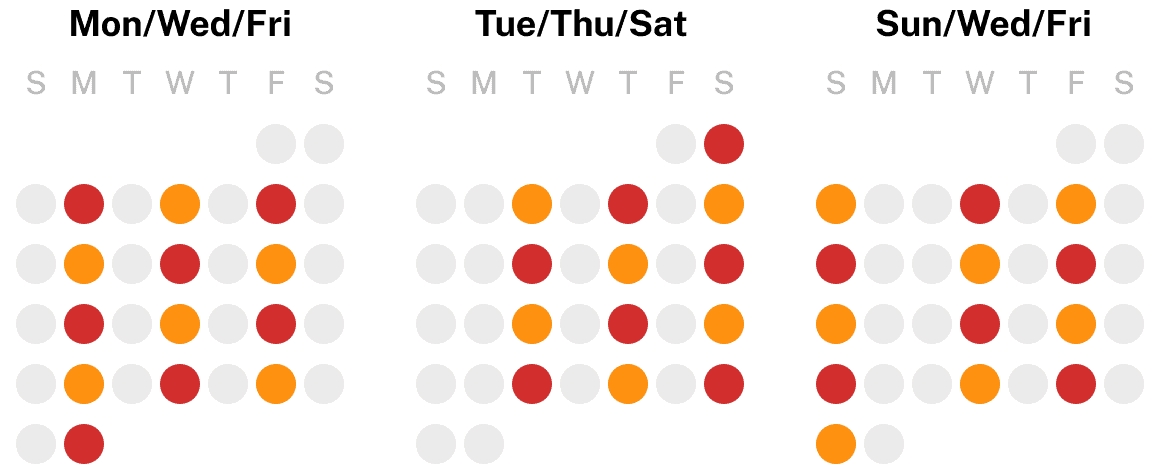
The Stronglifts app automatically alternates workouts A and B like this for you. It remembers what you did, and automatically switches your workouts while adjusting your weights. You can focus on lifting while we do the thinking.
Sets & Reps of Quarantine
Do 5×12 on the compound exercises of Quarantine – five sets of twelve reps. On the isolation exercises, do 3×12 – three sets of twelve reps.
5×12 means five sets of twelve reps with the same weight after you do your warmup. On unilateral exercises like Dumbbell Lunges, that means you do twelve reps for each leg. Like this…
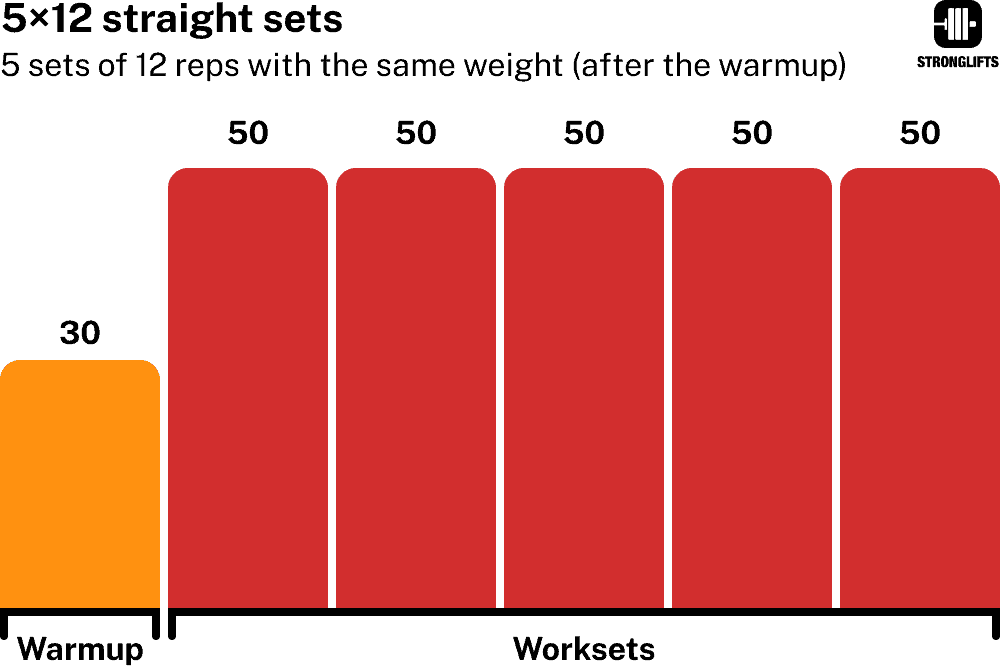
You can switch to top/back-off sets once it becomes harder to add weight with straight sets. You’ll know it’s time to switch when you start failing reps on set two to five. This is when you can start doing one heavy set followed by back-off sets with about 10% less weight. Like this…
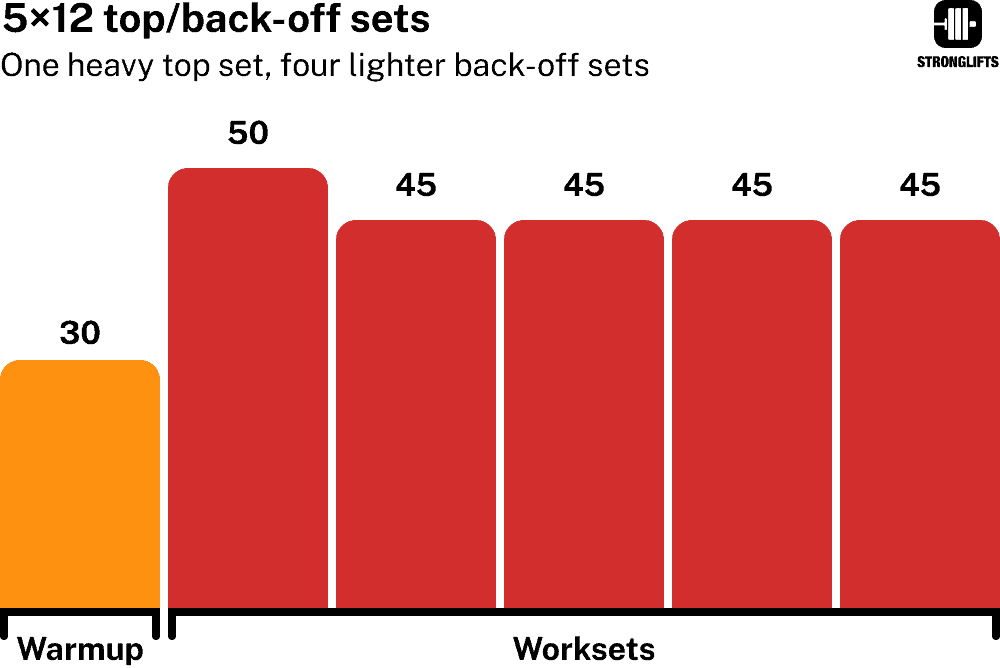
For more information, please read the guide on top/back-off sets.
Weekly Training Volume of Quarantine
Your training volume is how many weekly sets you do for each muscle group or movement (1, 2). Doing more volume typically results in more strength and muscle gains (1, 2, 3). Adding weight over time is the main driver of muscle growth (4, 5, 6). But you also need to do enough weekly sets.
Here’s Quarantine’s weekly training volume for your major muscles. Note that we’re taking the weekly average sets per muscle group because you alternate workouts A and B (some weeks you do A/B/A, some B/A/B).
| Muscle | Sets/week | Exercise |
|---|---|---|
| Chest | 15 | DB Bench, DB Incline Bench |
| Back | 7.5 | DB Row |
| Shoulders | 22.5 | DB OHPress, DB Bench, DB Incline Bench |
| Triceps | 22.5 | DB OHPress, DB Bench, DB Incline Bench |
| Biceps | 12 | DB Row, DB Curl |
| Legs | 15 | DB Lunges, DB RDL |
| Abs | 4.5 | Situps |
For hypertrophy, 10-20 weekly sets per muscle is recommended (2, 3, 7, 8, 9). A study by Schoenfeld et al found that doing ten sets per week or more results in about 20% more muscle gain compared to 5-9 weekly sets (2).
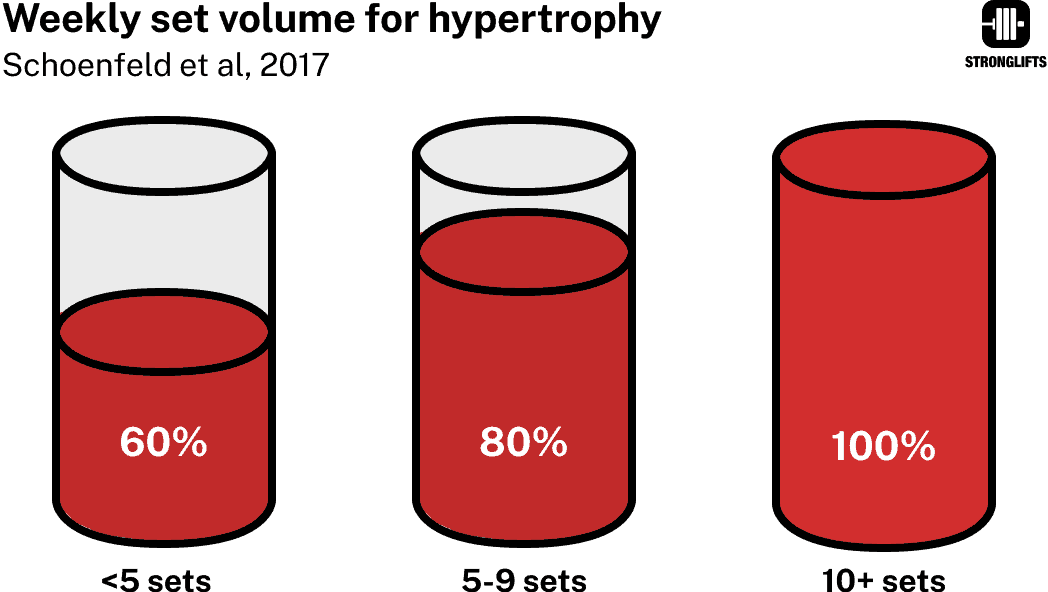
Of course the primary goal of the Quarantine program is not to maximize your muscle gains (this is something that takes years of training anyway). It’s to give you something short but effective that you can do to stay active and keep your gains while traveling. You can also do this program if you’re new to lifting and don’t have access to barbells to do Stronglifts 5×5.
You can log the Quarantine program with the Stronglifts app. Just go to program, tap Quarantine, select a template, and get started.
How The Quarantine Program Came to Be
Stronglifters have asked me for a dumbbell hotel gym workout for years.
Many of them travel a lot for work. They often end up in a hotel gym with only access to dumbbells. They can’t do Stronglifts 5×5 for a week or two. And so I frequently got questions about how to maintain strength and muscle while traveling. Here are examples of the kind of emails I’ve received…
I travel for work occasionally and am sometimes left with a very basic hotel gym. What do you recommend I do when I can’t squat, bench, deadlift with barbells? Should I try to mimic the best I can? Does using dumbbells, even if lighter, work? Obviously if I’m out of my real gym for a week I won’t progress but can I maintain during a lighter week?
-Geoff, 43, USA
I really like the Stronglifts 5×5 program and the app. I have been trying to stay consistent for the past few months, however I travel quite a bit. I am a pilot so typically gone for a week at a time. I don’t usually have access to a gym with free weights. Do you have suggestions on exercises to substitute for a short time so I don’t lose gains until I can get back to the gym? Usually we stay at hotels that have gyms with dumbbells.
-Joseph, 29, USA
I travel extensively for work and often do not have access to a squat rack or even barbells. I do usually have access to dumbbells in most of the hotel gyms, even if they aren’t heavy enough for where I am in Stronglifts 5×5. What substitute lifts do you recommend when all you have is DBs? How should you do your sets until you can return to the proper gym?
-Bill
The most common request was how to adapt Stronglifts 5×5 when traveling without access to barbells. Stronglifters wanted effective substitute exercises that they could do with dumbbells to maintain their gains while traveling.
Why I never created a hotel gym workout
The problem is that there’s no true dumbbell equivalent to heavy Squats and Deadlifts. You need a barbell to train these lifts hard.
You could curl dumbbells onto your front shoulders, and Squat that way. But anyone who has tried this with heavy dumbbells knows that getting them on your shoulders and keeping them there is more challenging than Squatting. It ends up being more of an arm than leg workout. Deadlifts are impossible to substitute because the dumbbells in most hotels aren’t heavy enough.
And so I never created a dumbbell version of Stronglifts 5×5 that you could do in a hotel gym. It just wouldn’t have been the same. Instead I recommended what I thought were much better solutions…
- Go to a Crossfit gym, get a day pass, and train during the open gym hours. I’ve done this for years while traveling extensively across three different continents. Crossfit gyms are everywhere. They have squat racks, barbells and benches, allowing you to continue your program. The day pass can be expensive, but it’s only for a few days.
- Do nothing. It takes three to four weeks of doing nothing before you lose strength (10, 11, 12). So you can simply not workout when you travel. I’ve often done this when I wanted to enjoy the holiday and get a break from the routine. If you train +48 weeks a year like me, a week off every 3-4 months is not just fine, it’s probably needed. You’ll get more sore when you resume lifting, but that’s about it.
For example, a study by Ogasawara et al had one group of beginners Bench Press 3x/week for 24 weeks without a break (13). The other group alternated six weeks of Benching 3x/week with three weeks of doing nothing. They got just as strong as the first group. The researchers did a similar 15-week study two years earlier, and they found the same results (14).
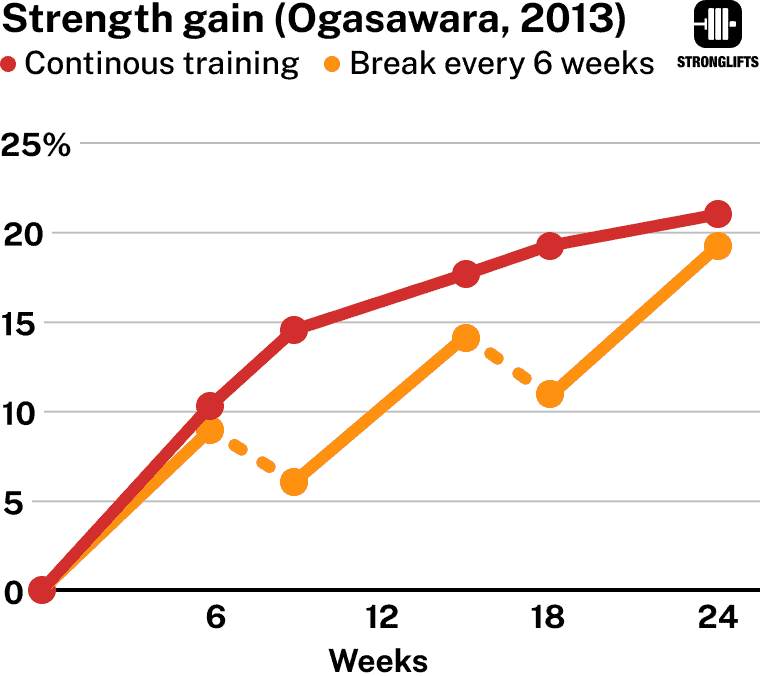
The same study also measured muscle gains (13). The group that Benched 3x/week without break built as much muscle as the one that took a three week break every six weeks. Some research suggests that periods of detraining may help muscles respond better when you resume lifting (15, 16).
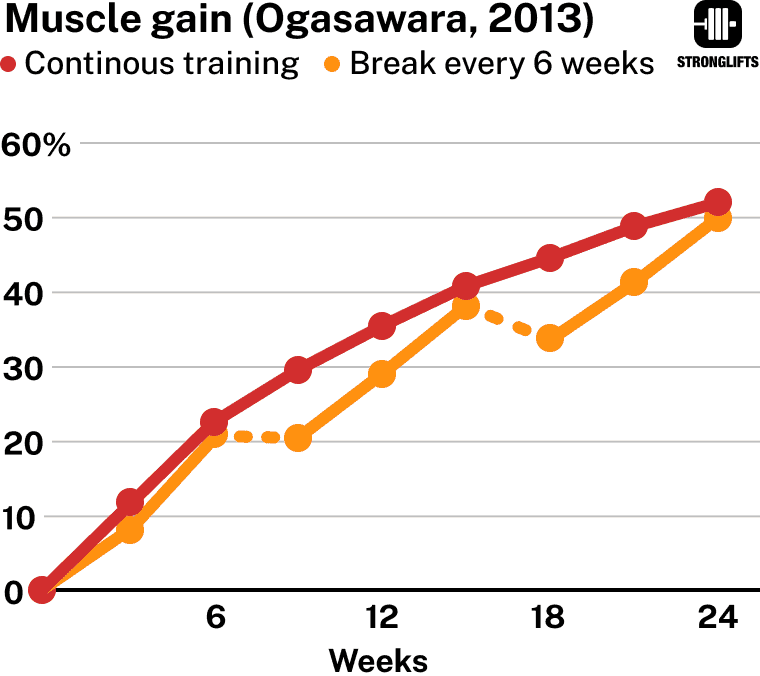
So when you’re traveling you can either go to a Crossfit gym where you can continue your program. Or you can just do nothing. Simple.
Why not everyone liked my solution
One, some Stronglifters travel to remote areas without Crossfit gyms. Or their busy work schedule makes it impossible to visit a gym outside their hotel. So while this solution always worked for me, it didn’t work for a lot of people.
Two, other Stronglifters don’t like skipping training for a week. They have a hard time picking it back up after the trip. Or they just feel better when they stay active. It makes them stick to their diet better. I never had these problems when I didn’t train for a week. But again, not everyone is like me.
Three, I was committing the logical fallacy of black-and-white thinking. It was either doing the most optimal training or doing nothing at all. There was no middle ground. This bias stemmed from the fact that for the first 21 years of my training career, I never did a workout in a hotel gym. I always ignored them because they lacked barbells. They looked like a waste of time.
How Covid-19 changed my mind
In December 2020, I did a 14-day quarantine in a hotel.
At the time, international travelers to several countries had to undergo a 14-day quarantine before entering. No exceptions. For the first seven days I was locked up in my hotel room just getting work done. I hate to admit this but it was quite productive. After seven days and several negative PCR tests, you were “allowed” one hour per day of exercise (like in prison!).
The hotel gym only had dumbbells of up to 50lb, a bench, and three cardio machines. Previously I would never have considered doing a workout there. But this time was different. I had been confined to a hotel room for seven days. No sunlight. Barely 1000 steps a day. Mostly sitting. My body urged me to get out of that room and be active for an hour. And so I listened.
The workouts had to be super short and effective. My goal was 30min of weights followed by 30min of cardio because I was sitting all day. I didn’t try to replicate the Squat with dumbbells. They weren’t heavy enough for that. Instead I worked the muscles. Each day I returned to my room with a good pump. To my surprise I really enjoyed doing dumbbell-only workouts for a week. This experience changed my mind about hotel gyms.
In fact, over the following years I continued to do dumbbell-only workouts in hotel gyms while traveling. It now rarely happens that I do nothing when I don’t have access to a Crossfit gym to do my regular barbell workouts. I take this as an opportunity to work my body differently than I usually do.
That’s why I decided to create a dumbbell-only workout for Stronglifters stuck in hotel gyms without access to barbells. And since this program is based on what I first did during a 14 day quarantine, I’ve named it “Quarantine”.
Quarantine FAQs
What if I don’t have a bench?
You can Bench Press with your back on the floor – that’s a Dumbbell Floor Press. Or you can do Dumbbell Flyes with your back on the floor.
The Stronglifts app can recommend alternative exercises if you can’t do the default ones due to lack of equipment or nagging pains. Just go to program, Quarantine, then tap replace exercises. You’ll get a list of substitutes with videos and instructions. Just pick one.
What if I don’t have an incline bench?
Hotel gyms usually have one. If yours doesn’t, just put something under the rear leg of your Bench to elevate it. This could be an aerobic step or so. Make sure it’s something sturdy that won’t move while you Bench.
If you’re training at home, you could put something like a step stool under the rear leg of your bench. I don’t have an incline bench in my home gym either. I put my flat bench incline by stacking plates under the rear leg.
If you have nothing to elevate the rear leg, then do a different bench exercise. You could for example do Dumbbell Bench Press in workout A but Dumbbell Flyes in workout B. Again, the Stronglifts app can offer you alternatives exercises. Just go to program, Quarantine, tap replace exercises.
How inclined should the bench be?
Not too inclined. Thirty degrees is fine. That’s why I’m not bothering getting an incline bench. You can easily elevate the rear leg of a flat bench.
Contrary to popular belief, a 45 degree bench angle does not work your upper-chest more (17). It turns the Incline Bench Press more into a shoulder exercise. Unless that’s your goal, just set the bench about 30 degrees incline. See the image below adapted from a study by Ridea et al (17).
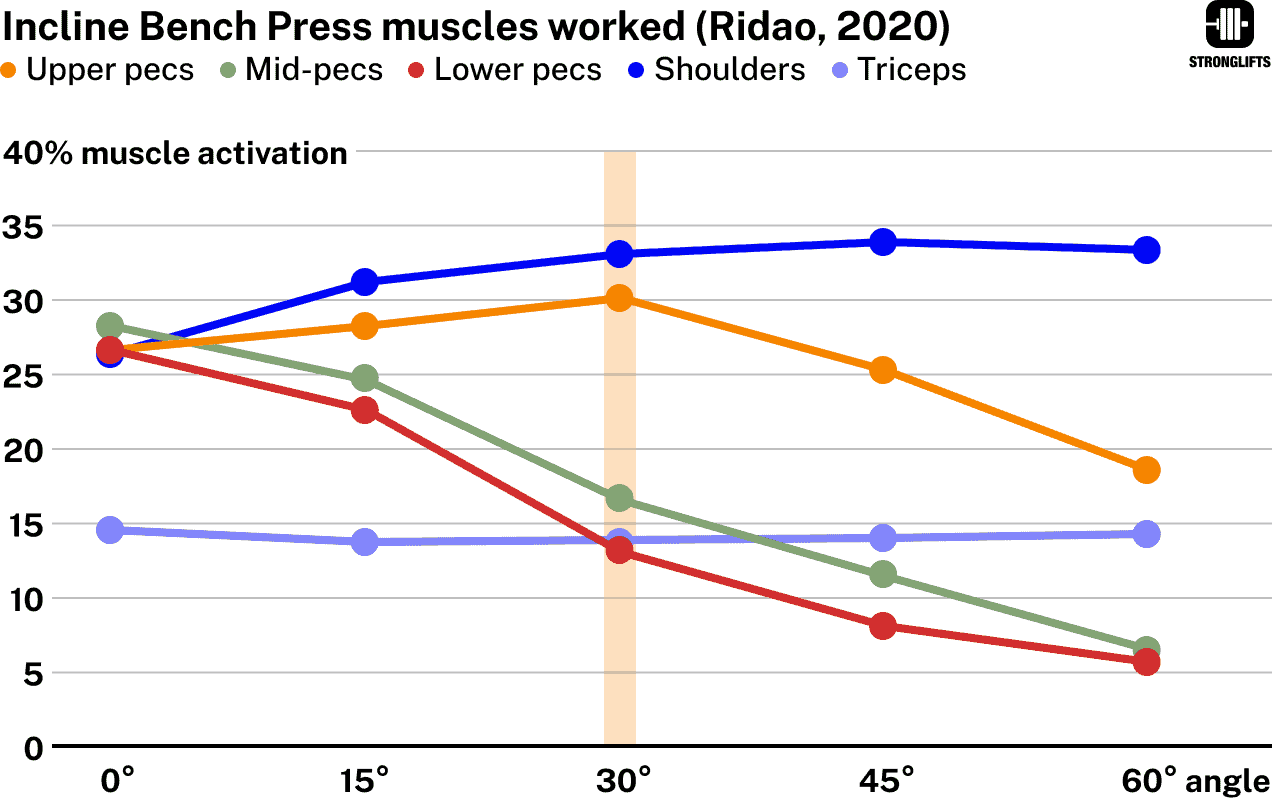
Notice how your upper-chest (the orange line) is less active when you bench with a 45 degree inclination than a 30 degree one.
Why not do 5×5?
To keep your sets challenging with the limited dumbbells in hotel gyms.
The heaviest dumbbells in most hotel gyms are 50lb or ~24kg. That’s fine for most guests who mostly do isolation like curls and flyes. But it’s not heavy enough for compounds, particularly for your legs. It’s definitely not heavy enough if you’ve followed a program focused on progressive overload like Stronglifts 5×5, and are now much stronger than the average hotel guest.
For example, my best Squat is 440lb for one rep. I’ve done barbell lunges with 220lb for 10 reps. For 5×5 Dumbbell Lunges I would need +100lb/hand. I’ve never seen a hotel gym with such dumbbells. Many regular gyms don’t even have dumbbells that size. That’s why I did 12 reps with 50lb dumbbells during my 14-day quarantine. Even that was too easy and I had to do Bulgarian Split Squats and slower tempo RDLs to keep the sets challenging.
You can get the same problem on DB Rows and DB Bench. 50lb dumbbells will be too easy if you can Bench 220lb with barbells. Doing more reps keeps the sets challenging when you’re limited by the weight. I had to go a step further and do the Dumbbell Bench Press with my feet in the air and a pause at the bottom to keep the sets challenging.
Beginners who get a pair of dumbbells to train at home rarely have access to heavier weights. Higher reps help them keep the sets challenging. 5×5 is not the best way to go if you only have dumbbells. You’re just going to run out of weights more quickly than if you used higher reps.
Why not call this Stronglifts 5×5 Dumbbells?
You’re not doing 5×5.
Plus I like the name Quarantine. It reminds me of those 14 days spent in quarantine in that hotel where I learned something new about training.
How to progress?
Add weight over time. Switch to heavier dumbbells.
If you complete twelve reps on all sets, add weight next workout. Pick the next heaviest dumbbell that you have available.
After a while, usually around 8-12 weeks, you’ll start struggling to progress. Switch to a different template of Quarantine. Change the exercises – instead of Dumbbell Bench, try Dumbbell Bench Feetup. You may need to lower the weight to get used to the different technique.
You can change the program template in the Stronglifts app. Go to program, tap Quarantine, swipe left/right for the different templates.
Why do different templates have different reps?
To artificially create progress and help you with technique.
When you switch from the Quarantine Intro to the Build template, the reps decrease from 5×12 to 5×10. With Advance, they drop again to 5×8. Lifting the same weight for two reps less per set makes it easier to lift. And so dropping the reps from 12 to 8 helps you to keep adding weight.
The exercises in the Build and Advance template are technically more challenging. DB Bench and DB Lunges become DB Bench Feetup and DB Bulgarian Split Squat. Balance is harder on these lifts. Lowering the reps shortens the sets. It makes it easier to focus and control the weights.
What if I fail reps?
Repeat the weight next time, but switch to top/back-off sets.
This means that you do one heavy set of twelve reps followed by four sets of twelve with about 10% less weight. This will stop you from failing reps on sets 2-5 so you can progress the top set, and move to a heavier dumbbell.

The challenge with dumbbells is that the progression is more abrupt and hard to sustain. If you Bench 200lb and add 5lb, that’s an increase of 2.5%. If you Dumbbell Bench 40lb, your next dumbbell is usually 45lb. That’s an increase of 10lb (2×40=>2x45lb) or 25%. One solution is to microload the dumbbells by putting a 1.25lb magnetic plate on each side. You can now progress in 2.5lb increments or 5lb total. That’s an easier increase of 12.5%.
You should expect to progress slower than with barbells. You should still add weight over time. But you won’t be able to do this every workout. In practice that means staying at the same weight for several workouts. When that weight becomes easier to lift, go up in weight. Give the heavier dumbbell a try every three weeks or so to see if you’re ready to lift it. If you don’t get 12 reps, that’s fine. At least you know where you stand.
The Stronglifts app supports smaller and slower weight increments. Simply go to start workout – tap the weight – change the increments from 5lb to 2.5lb if you can microload with magnetic plates. Then set the increment frequency from every workout to every 2-3 workouts.
How to switch back to Stronglifts 5×5?
Say you travel for a week or two. You do Quarantine in a hotel gym during this time. You’re back home and want to resume Stronglifts 5×5. What now?
Just resume where you left off. In the Stronglifts app, go back to program, tap Stronglifts 5×5, then resume your training. You should expect to get less sore than if you had done nothing during the trip. But you may still get sore as you didn’t train the exact same movement (this is particularly the case for Squats – while they work similar muscles as lunges, it’s not the same).
Should you deload when resuming Stronglifts 5×5?
You can. I usually start a little lighter if I do something like Quarantine for a week or more, and now resume barbell training. I do that because I like to ease back into training. I find it more motivating to build back up.
The research shows that it takes 3-4 weeks of doing nothing before you lose strength (10, 11, 12). This means that you don’t have to deload. However, the same workout that you did before your trip will make you more sore. You didn’t do the exercise for a week or more and so it will feel new again. Starting 5 to 10% lighter decreases the amount of soreness that you’ll experience.
The other reason to start lighter is that some lifters easily “forget” how to Squat if they don’t do it for a week or two. The bar can feel super heavy on their back when they unrack it during the first workout after their trip. This can impact their confidence and be demoralizing. Starting lighter can compensate for a potential loss in skills that makes the weight harder to lift.
5×12 means 6 or 12 reps per leg?
5×12 Dumbbell Lunges means twelve reps per leg. That means you do 24 reps in total. You have two ways to do this…
- Do twelve reps for one leg. Then do 12 reps for your other leg. That’s set one. Rest 2-3min, then do set two; OR
- Do both legs at the same time. One rep right, one left. Repeat until you’ve done 24 reps in total. Rest 2-3min before doing set two.
I always do both legs at the same time. You’ll get out of breath more, and your legs will get quite sore. But the sets will be over faster this way.
The exceptions are Bulgarian Split Squats and One Arm Dumbbell Bench Press. They show up in the later Quarantine templates. On these exercises I never alternate left and right. I complete all the reps for one side before doing the other side. This is because both exercises are harder to balance. A proper setup is important to achieve good balance and do hard sets. If you alternate on every rep, you would waste a lot of time setting up properly. So on these lifts I do all the sets for one side before switching to the other side.
Should you rest before doing the other side?
You can if you want. I rarely do.
Say we’re doing 5×8 Bulgarian Split Squats. I’ll do eight reps with one leg. Then I’ll immediately do eight reps with the other leg. After that I’ll rest 2-3min and do set two. High rep unilateral leg exercises can be quite uncomfortable. I don’t like to drag it and just want to get over and done with it. Short and hard.
The first argument for resting after training one leg is that your back leg gets tired on Bulgarian Split Squats. While your front leg does most of the work, the back leg isn’t doing nothing. At the very least it’s stabilizing your body while your front leg lifts the weight. This can create fatigue and discomfort. And so you could rest maybe a minute or so before switching sides.
The second argument is that your grip may give out before your legs. This can happen if you didn’t bring chalk or straps. You may need to rest a minute or so before doing the other side so your grip has time to recover.
If resting a bit before training the other side helps you better focus on form, stabilize yourself, and train harder, then do it. The only drawback is that you’ll spend a little more time in the gym. But given that the overall workout is already short, it shouldn’t matter too much.
5×12 50lb means 25 or 50lb per side?
50lb per side. 5×12 50lb means you hold a 50lb dumbbell in each hand.
Aren’t you lifting 100lb in total? When we use barbells we don’t specify the weight per side. If we put 100lb on each side of the barbell, we don’t say we Squatted 100lb. We say 245lb because that’s the total weight lifted including the bar. So why not use the same approach when using two dumbbells?
Because 50lb is the weight that shows on the dumbbell when you pick it from the rack. When you say you did 50lb Dumbbell Bench, it’s understood that you used 50lb/hand. If you said 100lb, we would think that you used 100lb in each hand. Following the proper convention makes communication easier. It also makes your life easier as you just pick the 50lb dumbbell from the rack.
Join the Stronglifts community to get free access to all the spreadsheets for every Stronglifts program. You’ll also get daily email tips to stay motivated. Enter your email below to sign up today for free.
References
1. Ralston, Grant W et al. “The Effect of Weekly Set Volume on Strength Gain: A Meta-Analysis.” Sports medicine (Auckland, N.Z.) vol. 47,12 (2017): 2585-2601.
2. Schoenfeld, Brad J et al. “Dose-response relationship between weekly resistance training volume and increases in muscle mass: A systematic review and meta-analysis.” Journal of sports sciences vol. 35,11 (2017): 1073-1082.
3. DE Camargo, Júlio Benvenutti Bueno et al. “Manipulating Resistance Training Variables to Induce Muscle Strength and Hypertrophy: A Brief Narrative Review.” International journal of exercise science vol. 15,4 910-933. 1 Jul. 2022.
4. Schoenfeld, Brad J. “The mechanisms of muscle hypertrophy and their application to resistance training.” Journal of strength and conditioning research vol. 24,10 (2010): 2857-72.
5. Kraemer, William J, and Nicholas A Ratamess. “Fundamentals of resistance training: progression and exercise prescription.” Medicine and science in sports and exercise vol. 36,4 (2004): 674-88.
6. Garber, Carol Ewing et al. “American College of Sports Medicine position stand. Quantity and quality of exercise for developing and maintaining cardiorespiratory, musculoskeletal, and neuromotor fitness in apparently healthy adults: guidance for prescribing exercise.” Medicine and science in sports and exercise vol. 43,7 (2011): 1334-59.
7. Schoenfeld, Brad, and Jozo Grgic. “Evidence-Based Guidelines for Resistance Training Volume to Maximize Muscle Hypertrophy.” Strength & Conditioning Journal, vol. 40, no. 4, 2018, pp. 107-112.
8. Baz-Valle, Eneko et al. “A Systematic Review of The Effects of Different Resistance Training Volumes on Muscle Hypertrophy.” Journal of human kinetics vol. 81 199-210. 10 Feb. 2022.
9. Bernárdez-Vázquez, Roberto et al. “Resistance Training Variables for Optimization of Muscle Hypertrophy: An Umbrella Review.” Frontiers in sports and active living vol. 4 949021. 4 Jul. 2022.
10. Hwang, Paul S et al. “Resistance Training-Induced Elevations in Muscular Strength in Trained Men Are Maintained After 2 Weeks of Detraining and Not Differentially Affected by Whey Protein Supplementation.” Journal of strength and conditioning research vol. 31,4 (2017): 869-881.
11. Mujika, I, and S Padilla. “Muscular characteristics of detraining in humans.” Medicine and science in sports and exercise vol. 33,8 (2001): 1297-303.
12. McMaster, Daniel Travis et al. “The development, retention and decay rates of strength and power in elite rugby union, rugby league and American football: a systematic review.” Sports medicine (Auckland, N.Z.) vol. 43,5 (2013): 367-84.
13. Ogasawara, Riki et al. “Comparison of muscle hypertrophy following 6-month of continuous and periodic strength training.” European journal of applied physiology vol. 113,4 (2013): 975-85.
14. Ogasawara, Riki et al. “Effects of periodic and continued resistance training on muscle CSA and strength in previously untrained men.” Clinical physiology and functional imaging vol. 31,5 (2011): 399-404.
15. Schoenfeld, Brad J et al. “Muscular adaptations in low- versus high-load resistance training: A meta-analysis.” European journal of sport science vol. 16,1 (2016): 1-10.
16. P. Fisher, James, et al. “Periodization for optimizing strength and hypertrophy; the forgotten variables.” Journal of Trainology, vol. 7, no. 1, 2018, pp. 10-15.
17. Rodríguez-Ridao, David et al. “Effect of Five Bench Inclinations on the Electromyographic Activity of the Pectoralis Major, Anterior Deltoid, and Triceps Brachii during the Bench Press Exercise.” International journal of environmental research and public health vol. 17,19 7339. 8 Oct. 2020.




